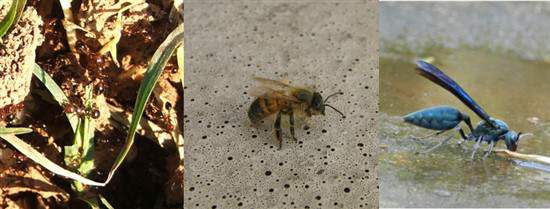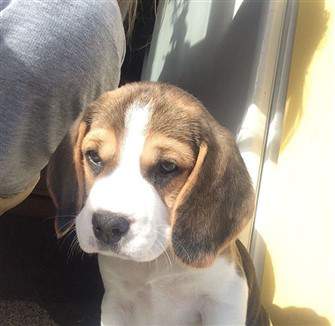If a Beagle is Stung by a Bee, Wasp, or other Stinging Insect
Overview
As warm weather starts heading your way, all throughout the summer and right up until frost starts showing on the ground, it will be prime time for dogs and other pets to be the victims of stinging insects.
This includes bees, wasps, yellow jackets, hornets, red ants and other pests whose stingers and venom can cause discomfort and even allergic reactions that may be considered an emergency.
Beagles tend to poke their nose around the very places where these insects make nests. While you may imagine bees and other stinging insects to nest in trees, many varieties make their home much closer to where a dog can reach.
This includes around the foundation of houses, under bushes lining the house and in shallow holes in the yard. Several bees including the digging, mining and sweat bees hover close to the grass, as most build their nests in the soil.
Just one sting can cause a reaction (even if a Beagle never showed a problem before) and of course, being swarmed can be exceedingly dangerous.
It is important to know how to react, treat and hopefully prevent insect attacks. This section will cover the most important aspects that you need to know, including:
- Particulars to know about each type of stinging bug
- How to react if your Beagle is being attacked by bees, wasps, and other insects
- At home treatment
- Signs of an allergic reaction to stings and venom
- Prevention

Left to right: Red fire ant, bee, wasp
Facts to Know About Different Insects
Fire Ants
– These are also referred to as red ants. There are many types of red ants and their stings can be quite painful. They build their nests in just about any type of soil, though many prefer open areas, which is the exact type of location that a Beagle may visit.
It’s almost impossible for a dog to be stung just once, since the ants swarm any invader that sits or lies on their nest.
The bites from red ants are painful and may lead to itching afterward, which in turn often leads to excessive licking. As with any type of stinging insect, a Beagle may have a rare allergic reaction.
Bees –Contrary to popular belief, not all bees die after stinging their victim. In fact, this is only the case with honeybees, though just one sting from a honeybee isn’t fun since the stinger is barbed which makes it hard to remove from the skin. If your Beagle is being swarmed by any other type of bee, they can be relentless, stinging numerous times.
Many people mistakenly believe that those ‘cute’ fat bees called bumble bees are friendly, however the females have stingers and will strike if they feel threatened. There are over 20,000 different types of bees and 70% of them make their homes at ground level or just under the soil, which is why it is not unusual for dogs to be stung.
Yellow Jackets
–
These are aggressive insects that can pack a wallop if they attack a puppy or dog. These insects both sting and bite and it is not unusual for them to do so without any provocation. Many yellow jackets build nests where Beagles have access: abandoned rodent holes.
Hornets
–
Though all insect bites can hurt, the sting from a hornet has more venom than bees or wasps. Hornets do not die after stinging and often can be found low to the ground in bushes and other shrubbery.
Wasps
–
If a wasp attacks a Beagle, it will rarely be one sting. also, elements in the venom of these insects slow down blood flow, which makes the pain radiate quite a long time. There are many types of wasps, though the Ground Digger Wasp is a danger for dogs since as the name implies, they nest at ground level where Beagles that love to dig
may disturb them.
How to React if Your Beagle is Being Attacked by Stinging Insects
It is important to note that no matter what type of reaction a Beagle has had in the past, a stronger reaction to any sort of sting can happen at any time.
For example, a Beagle may have been stung 10 times by a swarm of bees and was fine, but later may be stung by 1 wasp and have a bad allergic reaction. For this reason, whether 1 insect or a swarm of them is on your Beagle, your actions should be the same.
1) Do not attempt to hose down the insects, swat them off your Beagle with a towel or flail your arms. Any of these actions can cause the insects to attack more ferociously.
2) Take immediate action to remove your Beagle from the area of attack.
Most insects attack dogs due to believing that they are defending their territory.
Therefore, the goal will be to quickly leave the area. If you can, it is best to pick up your Beagle and run to shelter.
Most flying insects including African Killer Bees can be outrun and to this end, it is best to run in a straight line. If you are in an open area, you will want to get at least 50 yards away.
Sam - 2 year old rescue
Photo courtesy of Sydnee, Sandie, and Paul Moore
If you cannot pick up your Beagle and he is being swarmed, if you deem it safe to do so, you may wish to release him from his leash so that he may outrun the insects.
Some insects may chase you and your Beagle inside. If this happens, it can help to enter an interior room as bees and other stinging insects often become confused once inside and will fly toward the windows of well-lit homes.
3) Once safely inside, if there are any insects on your Beagle, douse your puppy or dog with soapy water. The film from the soap will help to immobilize any bees, red ants, etc. clinging to a dog’s fur.
If you cannot pick up your Beagle and he is being swarmed, if you deem it safe to do so, you may wish to release him from his leash so that he may outrun the insects.
Some insects may chase you and your Beagle inside. If this happens, it can help to enter an interior room as bees and other stinging insects often become confused once inside and will fly toward the windows of well-lit homes.
At Home Treatment if a Beagle is Stung
1) Stingers must be removed. With many types of stingers, venom will continue to be released into a victim’s bloodstream until this is done. The best method to remove stingers from a Beagle is to use a credit card to scrape each stinger out. Areas most vulnerable to insect bites or stings will be the Beagle’s face, paws and stomach, so do start there. However, it will be important to part the fur
and check the entire body for stingers.
Beau and Spot, both 1 year old
Photo courtesy of Shelly Roberts
2) Gently soap down and then rinse your Beagleif you did not already do this. Aside from removing bugs, the
shampoo will remove natural body oils that may impede further treatment.
3) Treat the pain and/or itch.
At home remedies:
If your Beagle was bitten by fire ants
- There are 3 different methods that may work. One is to soak cotton balls in pure ammonia, dabbing the bite marks. The other is to use a mix of baking soda and water and the last is to use meat tenderizer and water. No matter which option you choose, do this for 15 minutes.
If your Beagle was stung by wasps or hornets, a cotton ball soaked in vinegar and applied to the sting marks for 15 minutes can neutralize the alkaline in the venom.
If your Beagle was stung by bees or yellow jackets, a cotton ball soaked in a baking soda and water mixture and applied for 15 minutes can help ease the pain.
Ice:
If there is localized swelling, it can help to apply a small ice pack to areas on a Beagle that appear to have minor swelling.
Benadryl:
It is very important to note that Benadryl can be given to Beagles to help with MINOR reactions to bee stings or stings from other insects, however the puppy or dog must be monitored for any moderate to severe reactions (more ahead) regardless of whether or not this is given.
Typical dosing is 1 mg per each pound of body weight. This is given every 8 hours. Check with your vet before giving.
4) Monitor for allergic reactions and for excessive licking to bite/sting marks that may lead to raw skin and possibly broken skin which is then vulnerable to infection.
If a Beagle Has an Allergic Reaction to an Insect Bite
There are some important facts to note:
- A dog can have a reaction to a certain insect sting even if he did not in the past.
- A Beagle may fare okay with one type of bug (bee, for example) but have a very bad reaction to another (wasp, for example). The majority of dogs that are allergic to wasps are also allergic to hornets.
- It can take up to 45 minutes for a reaction to develop. For this reason, a Beagle should not be left alone for at least one hour after being stung.
- Benadryl for insect stings to dogs may not fully work. What may appear to be a minor reaction may only be partially fixed via the Benadryl and as the Benadryl wears off, signs and symptoms may worsen.
- In rare cases, a dog may enter anaphylactic shock, which is considered life-threatening.
Signs of Allergic Reaction to Insect Bites/Stings
You will want to keep an eye out for the following most typical symptoms:
- Facial Swelling – In moderate to severe cases, the lips and/or eye lids may swell.
- Swelling of sting site – While some minor swelling is expected when a dog gets stung, if the bump does not go down or worsens, this is a red flag.
- Odd Behavior
- This includes acting overly tired, confused or having marked lethargy.
- Trouble breathing - This includes raspy breathing, making gagging noises, heavy or shallow breathing.
Other signs may include:
- Rash
- Vomiting
- Pale gums
- Cold limbs
- Drooling
Zoe, 10 years old
Photo courtesy of Kirsten Iwen, from North Dakota
Emergency Treatment
- If your Beagle is experiencing any of the above signs or at-home remedies do not appear to help with pain or itching, it is vital to take your Beagle to the vet ASAP. For moderate cases, a medication such as Dexamethasone may be given and in severe cases, life-saving epinephrine may be injected.
If your Beagle is found to be allergic to a certain venom, the veterinarian may prescribe an EpiPen for you to keep at home and to take with you when you bring your Beagle outside.
Mason, 9 months old
Photo courtesy of Jasveer A.
Steps to Limit the Chances of a Beagle Being Stung
1) Supervise your Beagle when he is outside. If a Beagle is tied in one spot or is inside an enclosed fence, his options for running away from attacking insects is severely limited. Even if you think that your yard is free from any sorts of nests, these can pop up quickly in places that you do not suspect.
2) While Beagles do love to ‘follow their noses’, this puts them at risk of disturbing ground nests and subsequently being attacked by insects. Flower beds are often ‘hot spots’ for bees. Unless you are sure that the area is safe, limit how much sniffing your Beagle does under bushes, in gardens and around other shrubbery.
3) Yard work
such as mowing the lawn, weed whacking or pruning bushes can disturb stinging insects; when you do these tasks, it is best to keep your Beagle in the house.
4) Routinely check your yard
for nests and call a processional exterminator for removal if you are not confident that you can remove them yourself.
5) If you notice a large colony of bees or other insects in a public dog park, this can be reported to the town/city to be dealt with. This helps keep your Beagle safe during future visits and helps prevent other dogs (and their humans) from getting stung as well.
You May Also Like:
Beagle Care Tips
- A helpful list of the top things that you will want to pay attention to, in order to provide optimal care.








